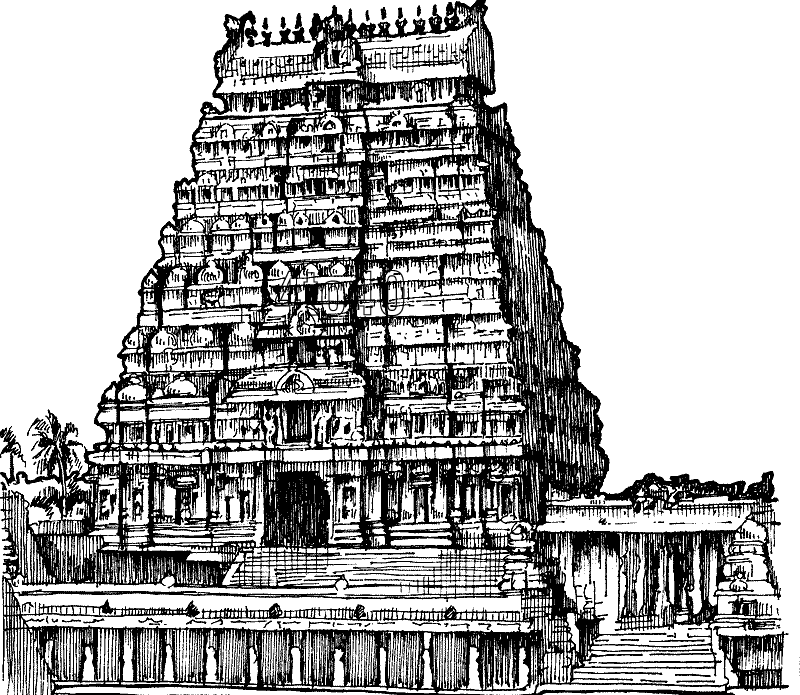Friday Temple Visit - Week # 99

06th January 2023
வாரம் ஒரு கோவில் தரிசனம்
by S. Subramaniam
Shri Kailasamundaiyar Temple, Cholamadevi, Trichy, Tamilnadu, India
Location

Shri Kailasamundaiyar Temple is a Hindu Temple dedicated to Lord Shiva located at Cholamadevi Village in Tiruchirapalli District of Tamilnadu. The temple lies on the banks of River Uyyakondan and is about 18 Kms fro Tiruchirapalli and 5 kms from Thiruverumbur.
Uniqueness:
This is one of the many temples built by Raja Raja Chozhan (985-1014 CE), and one of the rare temples built exclusively to spread the Adi Shankara's Advaita philosophy.

Salient features:
The name of the presiding deity is Shri Kailasamundaiyar and name of Devi Patvati is Karpagambal. Vilvam is the Holy tree (Sthala Vriksham) and the Uyyakondan river serves sd the Holy waters (Sthala Theertham) of the temple.
Name of the place & and the Lord:
As per the inscriptions available the village was once called as 'Thenkarai Brahmadeyam Sri Cholamadevi Chadurvedi Mangalam'. Later days the place was referred to simply as Cholamadevi, the name of the 13th wife of Raja Raja Chozhan.

The Lord has been named in this temple as Kailasamundaiyar or the Lord of Mt. Kailash to provide an option to devotees, who are unable to visit the holy abode of the Lord in Himalayas, to visit this temple.
History
The temple was built by Raja Raja Chozhan in 991 CE on the request of one of his queens Chozhamadevi who was his 13th of his 18 wives believed to be his favorite one. The king also built a palace for her and a garden measuring 7 acres.
Inscriptions

The temple is a virtual treasure house of historic information pertaining to the Cholas. The adhishtana and the walls of the temple are fully covered with inscriptions belonging to the periods of Raja Raja Chola I, Rajendra Chola I and Vira Rajendra Chola I
One of such inscriptions contain the earliest known reference to Shankara Bhashyam, a commentary on Sankara's philosophy, written by Chidaananda Bhattaara. The inscription is in Tamil with a few Sanskrit words in between written in Grantha characters.
Let's get to know about Varttika
The temple was exclusively built to spread the Adwaita philosophy of Adi Shankara. A huge well decorated hall was constructed to conduct classes on Vartikka.

Meaning of Varttika
Varttika (similar to Bhashyam) is a Sanskrit term defined as a work that offers a detailed commentary on a text or teaching. Varttika details out what has been said, what has not been said and what has not been clearly said.
The Varttika taught at Cholamadevi temple was a book written by Chidaananda Bhattaara referred to above. Unfortunately, Chidananda Pidarar’s Varttika is lost to us. There is also no information about itsc composet Chidananda Pidarar.
The only thing that is clear from the inscriptions is Adi Shankara’s Brahmasutra Bashya, popularly known as Saareerakabhashya in Tamil was very popular. A book was written in Tamil about this work of Adi Shankara amd the Varttika was considered significant enough for a Chola king to make arrangements for it to be taught in a temple.
The Temple
Apart from the importance of the inscriptions, the temple itself is rated as an architectural marvel and built as per specifications of the Silpa Shasthra.
Other Deities

The main shrine has the big relief images of Dwarapalas looking somewhat similar to the images of Tanjore Big Temple.
Shrines for Lord Ganesha, Dhakshinamoorthi, Bhikshatana, Vishnu, Brahma and Durga are found as koshta idols surrounding the temple wall. While Ayyanar is seen with his two consorts, Muruga is seen only with Valli. There is a shrine for Saptakannikas.

There is a small hole with the relief image of a snake; it is the hole which has been set up for the snakes to enter the temple to worship the Lord on certain specific days, it is generally believed.
Contact
Shri Kailasamundaiyar Temple
Thiruverumbur Rd, Cholama Devi Village, Tiruchirapalli, Tamil Nadu 620011, India
Phone no : NA
Disclaimer: All matters contained in this article are the property of www.templesofasia.com. The opinions expressed in this article are purely that of the author. The author alone is responsible for the accuracy, authenticity, completeness and validity of all the information in the article.


Kommentare